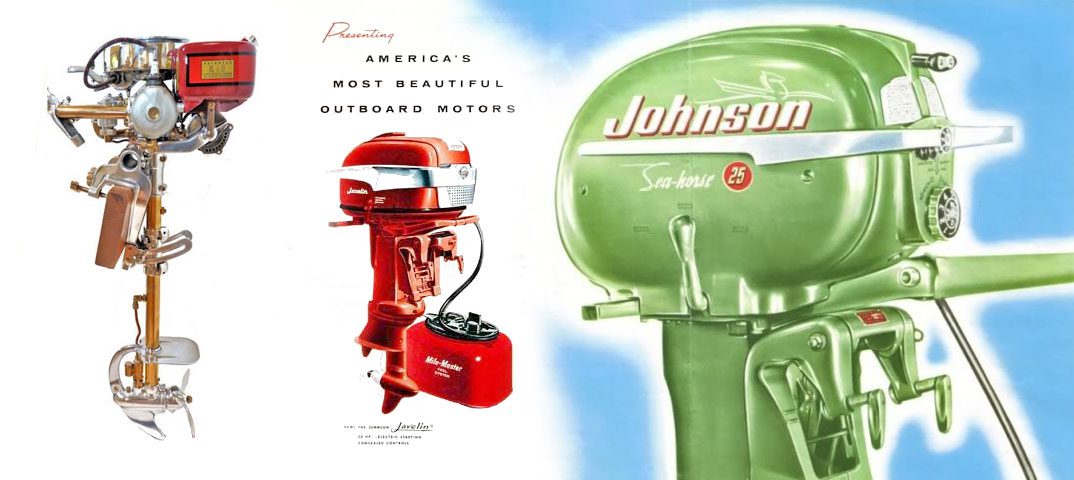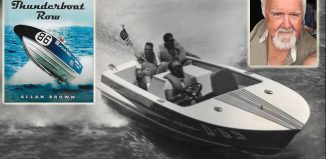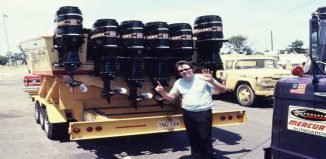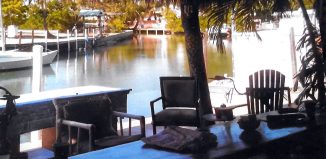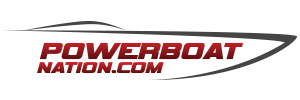After five years of working at the local Johnson Outboard and Schwinn bicycle dealer, Sayre and Co., in Terre Haute, Indiana, I figured that I was probably the greatest mechanic in the world. Starting on my 16th birthday (Child Labor Laws) I had worked, part time, through my Senior year at Garfield High School, and all the way (almost) through Indiana State Teachers College. The outboard work consisted largely of providing life support for ancient, little bitty outboards, all pre-war, and all unsullied by salt water, year round use, etc. No recoil starters, no gear shifts, etc. One tale comes to mind, involving a 2 ½ HP Johnson on an 8’ long Hagerty Sea Shell pram, which was an extremely popular ‘car-top’ fishing boat. Paul “Pappy” Steurwald, a local WWII Air Force veteran, and hero, was one of my favorite customers. We were on the eve of our local bass fishing tournament, “The Bassathon”, to be contested on the brand new water reclamation project lake, Cagle’s Mill Reservoir, when Pappy brought in his little motor, and complained that it was extremely hard to start. There wasn’t much to it, a single cylinder, rope start, direct drive, tank on top, etc. He had added a much larger rope cover on the flywheel, allowing him to wrap several turns around the flywheel. When it was ready to start, he would place one foot against the transom, and pull mightily on the rope, probably spinning the engine at two or three thousand RPMs. It couldn’t help but start. He left it with me to fix. I discovered that it had little or no compression, and set out to repair it. I honed the cylinder and installed new piston rings and base gasket. Voila! I could actually start it by turning the flywheel by hand. He picked it up while I was in class, so I was not able to warn him about ease of starting.
We met at the Lake on Friday evening, prepared to fish all night. The prize was a silver cup, full of silver dollars. My big brother, Bob, and I were fishing together in another Hagerty with no motor, and just happened be right next to Pappy at the launch. He was pretty well oiled up, as were the balance of the hundred fisherman, except for Bob and me. “This goddam thing gonna start?” Before I could answer, he gave a yank, and, good news, the engine started on the first revolution. Bad news? There were five or six feet of rope wrapped around the flywheel, with a wooden knob on the end. As the boat started across the lake, the wooden knob swung out farther and farther from the motor, whacking Pappy on the knuckles, nose, etc. It was also driving him forward in the boat, until he was sitting on the bow, facing aft, with the rope whacking him rapidly. Mercifully it motored into shore, and Pappy rolled off backwards, to safety. Pappy looked like a bag of walnuts, with lumps all over. “Nice job on the starting there, Brown”.
I had had a brief love affair with one of my fellow students, a girl, actually, which curdled with a disagreement over, umm, rights and territory. I was sick of romance, my smelly hometown, school, poverty, potential teacher pay, stuff like that. I had just learned of the Florida Keys, and, as a card-carrying water baby, got my Johnson sales rep to set me up with a job in Miami. That turned out to be Challenger Marine, in North Miami, Florida. In September, 1956, I lit out. I drove my speedy 1949 Studebaker all the way down US41, and arrived in Miami in 24 hours. I reported to Challenger Marine, only to learn that their regular outboard guy had recovered from an injury, and that I would be working part time. Suited me fine. I had a good set of tools, and immediately went to the Keys, where I found some work and a nice piece of deserted waterfront to share with the bugs. I met countless people down there, and made connections that have lasted my life. I got to experience my first hurricane, the end of 1956. It wasn’t much, but it sank lots of boats in North Miami. I was called in to work at Challenger Marine. Asked if I could do ‘basket case”, I replied “Hell yeah”. I was wrong. While my experience up north had some value, I had never actually seen the inside of 25 or 30 HP modern outboard. The head outboard mechanic, fortunately, was Bob Westbrook, and Bob and I hit it off big time. He was very patient with me, and better than that, we bought a bunch of sunken motors, and overhauled them at his house at night, while drinking beer and lying. We made enough money on our clandestine enterprise for me to buy an old Charter boat from the Atlantique Dock, next to the fabulous Castaways Motel dock. Spring break was big in those days, and I sometimes had 15 or 20 paying sleepers on my “Yacht”. Strangely enough, they were all girls, and not all of them had money. Although it was not in my curriculum, I taught them something about economics, and a couple of other areas.
Challenger was owned by Dudley Whitman and Art Siegel, two of the nicest men on the planet. They were honest, God fearing family men, and fun, active guys. For instance, we took on a dealership for the new Atlantic and Pacific Hydrofoils, which came in a kit to attach to our 16’ Challenger outboard boat, that we built in small quantities. We installed a set, along with a 25 or 30 horsepower Johnson motor. One of our best customers happened by, just as we were launching the contraption. Dudley was test driver, and he and Daddy Warbucks headed out Arch Creek (Named for an Indian named Arch, who was a Creek, apparently). They were able to “fly” it out to Biscayne Bay, with no wake whatsoever. Dudley’s partner, Art, had a camera ready, and when they came back, at about 30mph, Art snapped away. It is only about 50 yards from the fuel dock to the Biscayne Boulevard bridge. I could see Dudley pull the throttle back to idle as he passed the fuel dock, but the boat did not slow perceptibly. They went through the bridge and out of sight silently, until we heard a noise like you hear when a large truck falls on Wiley Coyote. Another fine mess, somebody made a gyrocopter blade kit to be installed on a towed boat. Art installed it on a 12’ aluminum boat. The blade was about the same length as the boat. Dudley ran the towboat, an old Chris Craft (We were Chris Craft Dealers) runabout. With about 100 feet of towline, the towboat accelerated slowly, to about 25 mph. The big blade was rotating, flop flop flop, and nothing else was happening. We’re gonna need a faster boat. Dudley borrowed a customer’s beautiful twin engine Canadian built Shepard runabout, and added a longer towline. 30mph, flop etc. 35mph, flop, etc. 37mph. SPRONG!!!! The blade picked up rpm’s, stiffened, and before you could say HOLY SHIT!, Art was 100 feet in the air! Although we could not see him from below, we knew exactly where he was from the screams. Dudley got him down safely.
We were on a roll! Dudley had been a “Hump” pilot in WWII, and had crashed a PT19 trainer in Biscayne Bay during training, so we were pretty much ready for anything to do with flying. A salesman came by with a brochure for a seaplane. Something new, called the “Lake Skimmer”. It was pretty, had a single engine mounted like an undeveloped sibling on its back, and seated four. The salesman offered a demo, and Art and Dudley said “Hell yeah!” The salesman landed on Biscayne Bay, and taxied to Beer Can Island. I took Art and Dudley out there in our workboat, the “Huff and Puff”. Dudley went first, since he was an actual flier, and executed some nice figure eights, took off and flew around for a few minutes, then landed. Art’s turn. Art did not have a license, so he was confined to goofing on the water. After a minute or two, he spied a wake, didn’t tell the salesman, and crashed into it. The impact stove in the front landing gear hatch, and fifty or a hundred gallons of salty Biscayne Bay joined them in the cockpit. The salesman took over, skimmed UNDER the Broad Causeway draw span, holding the nose up with the controls, and barely got it to the seaplane base at 112th St. No Sale.
That was so much fun, that Dudley bought Jordan Klein’s Cessna 195, a big single engine taildragger plane, high wing, no spars, and a nine cylinder radial Jacobs “Shaky Jake” 300 HP engine. It was a pretty nice plane, and except for “ground looping” on the acceptance flight, it was good. By now, I was sales manager, and we did a lot of ‘bidness’. Dudley and I flew all over, appraising trade ins, boat shows, stuff like that. He let me fly sometimes. Once, we flew to Marathon, in the Florida Keys, to appraise a 22’ Trojan trade in. Dudley, “You want to land it?” “Hell yeah!” The runway there is ex WWII, and pretty long. I flew past on the downwind leg, turned on final, and lined it up. I tried to do a three point landing, but settled for a pretty good two pointer. “Whaddya think, Boss?” “I think it would have better if you had landed at the actual airport. It is a mile and a half up that way…” Dang! I will make it up on trip back to Opa Locka Airport. It is fun to land a taildragger on a long runway, as you must keep the tail up to be able to see, and to keep the engine cool. I did everything by the book. When we stopped, I started toward my car, when Dudley called for me to turn in the life raft that we had rented for the flight. “No problem, Boss”. The plane was tall and I could barely reach it. I could just finger it, and, as I pulled to toward me, I heard “Oh, no!” I can still see Dudley’s face, jammed against the windshield, again like our friend, Wiley. I stuck the raft with my pocket knife, and Dudley’s voice went from “Mmfmmgitzibug”, to “Gee, Brownie, in the future you should be more careful”, or something like that. Hell yeah!

